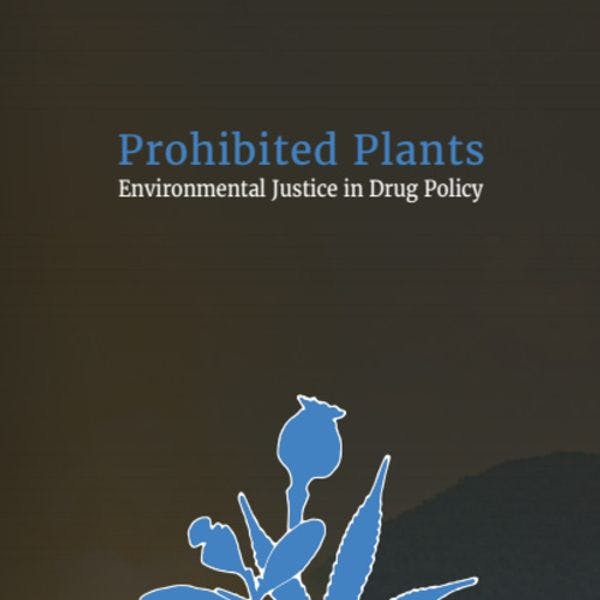Plantes prohibées : Justice environnementale dans les politiques en matière de drogues
TNI examine le lien entre drogues et environnement, ses implications pour les travailleurs ruraux et pose un regard critique sur les réponses que les politiques en matière de drogues et de développement apportent dans ce domaine. Pour en savoir plus, en anglais, veuillez lire les informations ci-dessous.
By Sylvia Kay / Transnational Institute
Across the world, the state of environmental stress is unprecedented. This includes major threats to the lands, soils, waters, forests, and oceans that make up our ecosystems and biodiverse nature. Cutting across all of this are the unfolding effects of climate change and global heating. All of these developments will continue to have dramatic impacts on both people and planet. These impacts are however not evenly distributed. As scholarship and activism on ‘environmental justice’ points out, poorer and marginalised communities, often differentiated along class, gender and racial lines, face particular exposure to environmental harms. This holds particularly true for populations in the global South.
The role of illicit drugs in relation to these environmental stresses is an underexplored terrain. Yet, as this report will argue, drugs, as well as the policy responses to them, are an environmental issue. This disconnect between drug and environmental policy is the result largely of the institutional compartmentalisation of the issue of drugs into the domain of crime and law enforcement with little outreach to other spheres related to the environment or sustainable development. References to the environment within drug policy have as such remained sparse and limited in scope.
This is slowly changing. A resolution on alternative development adopted by the Commission on Narcotic Drugs (CND) - the central drug policy-making body within the UN system - in March this year gave special attention to environmental protection, encouraging “Member States to examine and address, within the efforts of alternative development, the harmful impact of the illicit cultivation of crops used for the production of narcotic drugs on the environment, which may lead to deforestation and the pollution of soil and water, and to seize the opportunities offered by alternative development with regard to the conservation and sustainable use of the environment and the protection of biodiversity”.6 And for the first time this year, the 2022 United Nations Office on Drugs and Crime (UNODC) World Drug Report will include a special booklet on the connection between illicit drugs and the environment. This follows on from an increasing number of official side-events that have been organised in recent years at the CND in Vienna on the issue of drugs and the environment.
This report, which draws on TNI’s original research, fieldwork, interviews and a broad literature review, aims to add to this burgeoning debate in the following ways:
By examining the drugs-environment nexus in relation to trajectories of agrarian change and the implications for rural working people, especially in the global South. This is in recognition of the fact that what are currently deemed to be illicit crops under the international drug control regime often have a long history of traditional cultivation and use by rural communities and indigenous peoples across the world. In addition to longstanding traditional uses, many more rely on the cultivation of illicit crops for both their economic production and social reproduction activities. At the same time, these rural people are often most at risk of poverty, marginalisation, discrimination, and criminalisation while being least represented in policymaking spaces and in decisions that affect them. Elevating the voices and perspectives of these growers of illicit crops (or producers of prohibited plants) and the communities in which they are embedded is therefore a key aim of this report.
By critically interrogating both drug policy and development responses in relation to the drugs-environment nexus. From toxic eradication campaigns that spray the ground with chemicals, to interdiction efforts which push illicit cultivation into ever more fragile ecosystems, drug control policy has been responsible, directly or indirectly, for a number of grievous environmental harms. Additionally, crop-substitution programmes which ignore the fact that for millions of peasants, small farmers, landless, and migrant labour populations, drug crops are the alternative development to trade and investment regimes from which they are either excluded or adversely incorporated into will ultimately fail.
By bringing in scholarship and literature from, inter alia, the field of political ecology and critical agrarian studies and applying this to the issue of drugs and the environment, it is hoped that further exchange between these two hitherto quite separate spheres of enquiry can be stimulated. Drugs are an environmental issue. By making this case, it is hoped that policymakers, researchers, civil society organisations and social movements from both fields can be encouraged to engage in a process of mutual learning and knowledge exchange. Through this bridge-work, new forms of solidarity, scholar-activism, and policy change can coalesce around, for example, movements for climate justice, agroecology, or peasants’ and indigenous’ rights.
